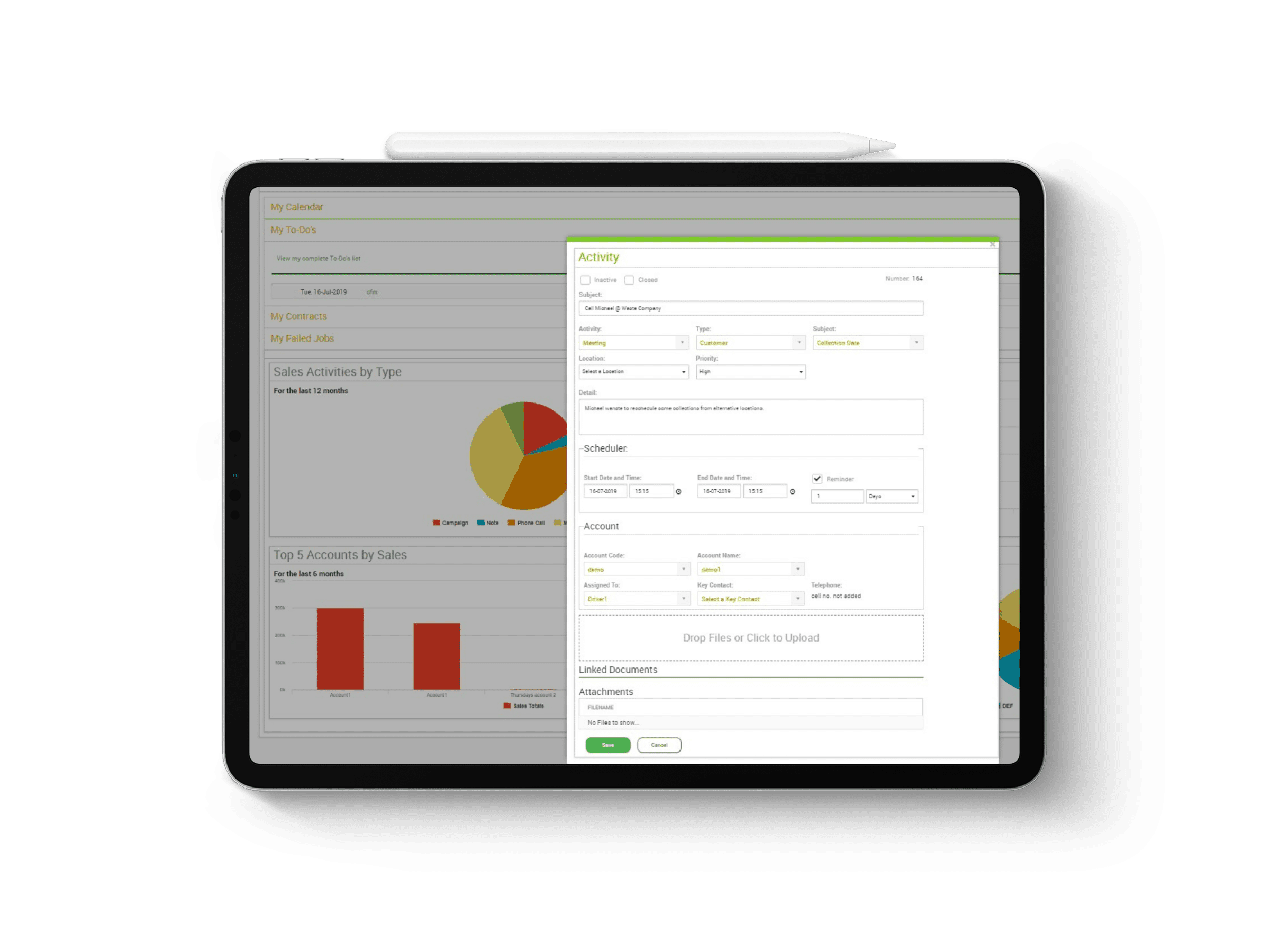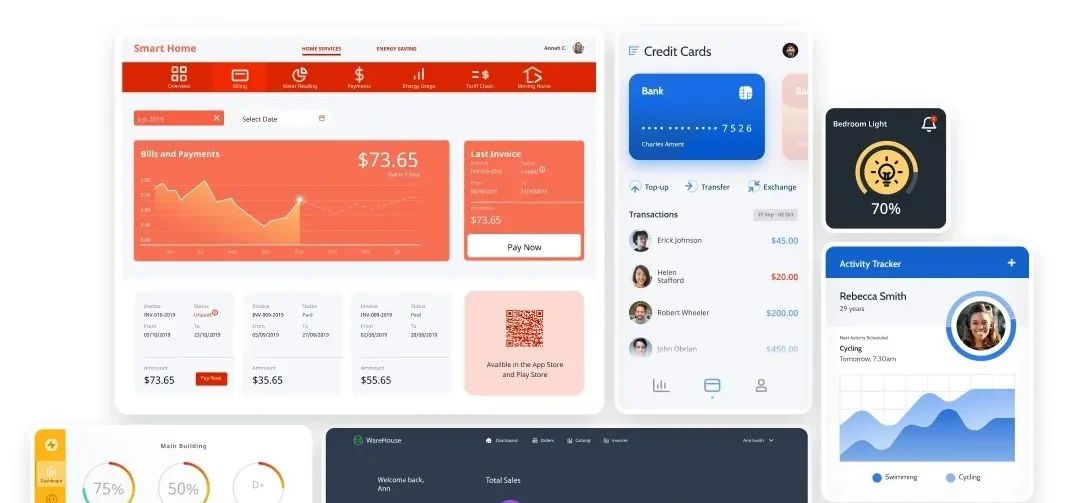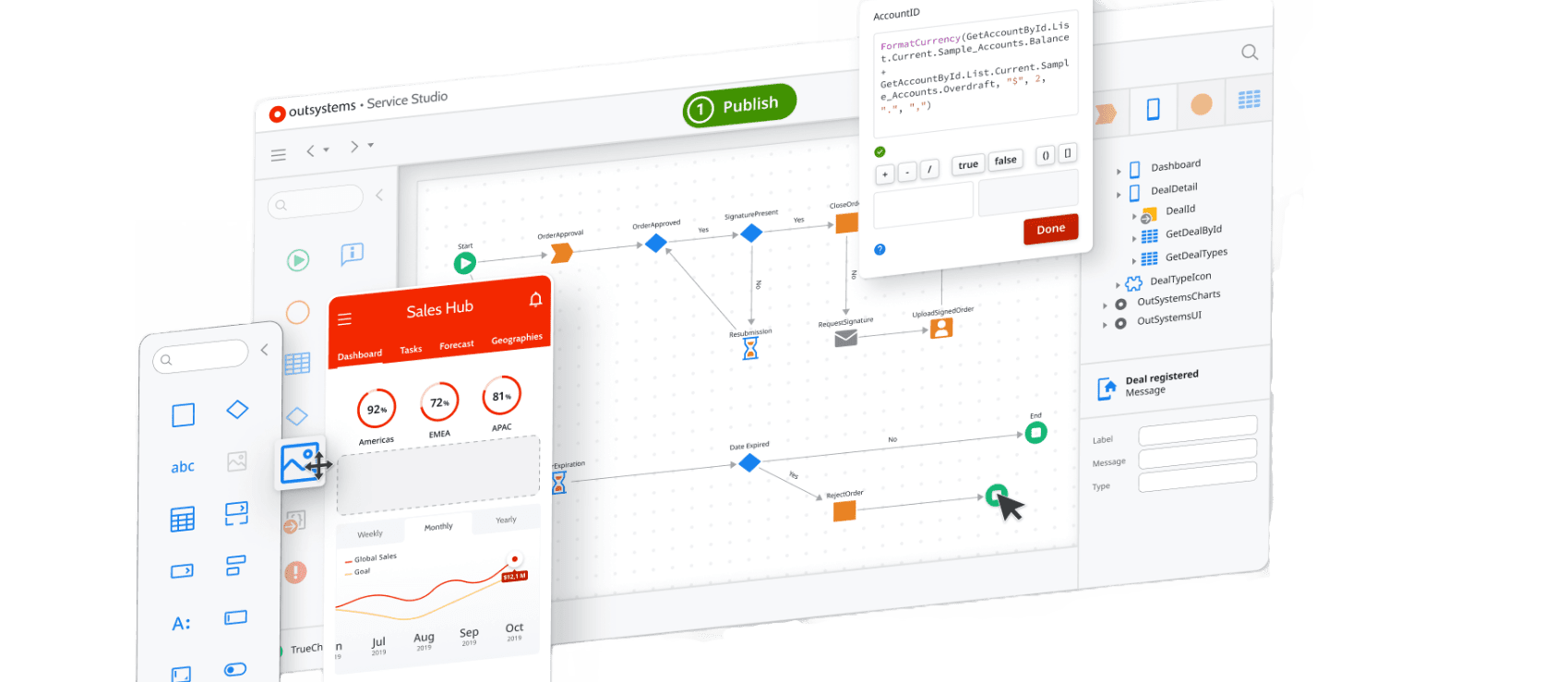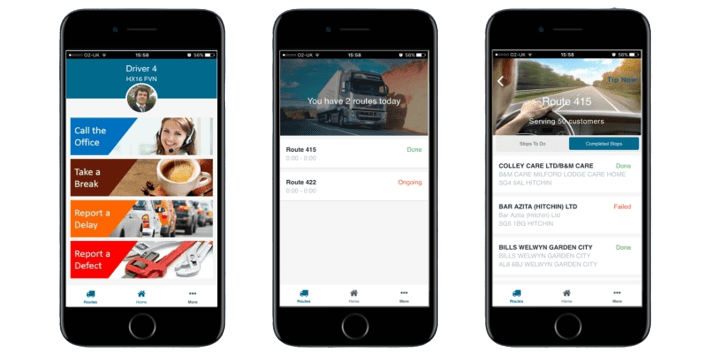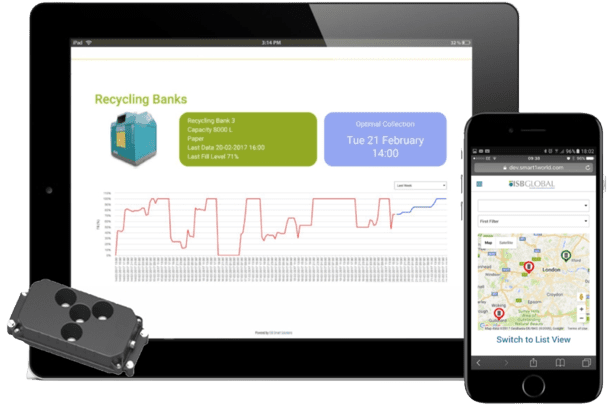Case Study SAP Mobile App Harnessing the innovation of OutSystems to allow remote users to carry the power of SAP anywhere, anytime, on any device. DISCUSS YOUR IDEA → Challenge Faced with a decentralised user base, a complex SAP user interface and challenges with infrastructure, one facilities services company challenged ISB Global to take WR1 mobile; to reach 150 users across the UK and Ireland. Many companies face similar challenges; which is why ISB set out to create a truly mobile solution, integrate it with SAP and make it available on a subscription basis as a software-as-a-service (SaaS) solution. Solution The architectural complexities of delivering a SaaS solution and the need to connect to multiple ERPs meant a traditional mobile development approach would have taken too much time resource to develop and deploy. Utilising the OutSystems Platform the mobile application could be brought to market much faster – in a matter of weeks rather than months, thanks to OutSystems’ off-the shelf SAP integration and multi-tenancy capabilities. Benefits With tight integration to SAP, it provides field employees the ability to record and monitor customer service requests via mobile and web devices. Its intuitive and easy to use interface increases staff efficiency and reduces training needs. It is a 100% SAP integrated cloud solution that renders only the data needed to complete a job as efficiently as possible, guiding users through the process. Plan your project → Carry the power of SAP in your pocket. Real-time integration with on-premises ERPs. DISCUSS YOUR PROJECT → Join the smart community Subscribe You have been successfully Subscribed! Ops! Something went wrong, please try again.
Unlock the power of your systems by extending SAP
Unlock the power of your systems by extending SAP Pritesh Pattni Unlock the power of your systems by extending SAP If you’re already using SAP in your business, you’ll know that it brings considerable benefits. SAP is global leader in in enterprise applications, helping businesses to run more efficiently, serve their customers better and plan for growth with confidence. SAP is constantly innovating, with its latest version, SAP S/4HANA supporting AI and machine learning capabilities, giving customers even more insight and value. You can take advantage of that value by extending your own SAP system – and this is easier and more cost-effective than you might think. If you’ve previously gone through a complex digital transformation to bring SAP into your business, then relax – when you work with the right technology partners, extending your SAP system can bring a number of benefits: Supporting growth – as your business grows, your technology needs to be able to keep pace. Failing to update your technology can cause technical debt, which in turn will slow your business down. Instead, choosing to plan and implement a structured extension of your existing system will mean you have the right technology in place to support your growth plans. Reduce maintenance worries – if you extend your SAP applications in a planned way, you can ensure that the core of your system remains ‘clean’. It’s important to work with the right people and technology when you extend, so that any work is centred around the continuity of your existing systems. Done properly, this will help to maintain a system that works well and requires less maintenance in the long term. Customisation – you will have already configured your SAP application to meet your business needs. But as those needs change, SAP may not cover some of your new business areas, or may require adaptation to keep pace. Extending SAP allows you to customise the system to the way your business works, giving you the best possible value for your investment. Integration – one of the worries about adding new technology to your business is how it will integrate with your existing systems. Working with a tech partner that is a SAP specialist means that you can extend capabilities without compromise. SAP has a dedicated integration suite which helps to maintain integrity across systems. Future-proofing – you don’t know what’s around the corner. So extending your SAP capabilities allows you to put your business in the best place to handle unexpected events. That way, there are no sudden, unexpected costs, and you can be confident that your business has the technological capability to react positively to change. Better employee experiences – extending SAP isn’t just about processes; it’s about people. Your employees can get frustrated with technology that doesn’t quite work the way they need it to. But you can create personalised experiences that help to make your team more efficient and – even better – happier in their work. Scalable SAP transformation with OutSystems At ISB Smart Solutions, we’re a proud OutSystems partner. We use OutSystems to support clients who are extending their SAP, because we know it delivers a fast, reliable solution. OutSystems is a low code pioneer. Low code is a method of software development that lowers costs, reduces the manual errors associated with ‘hard coding’ and delivers flexibility and accuracy to end clients. Using OutSystems means we can build customised extensions for SAP users. And, of course, because we are also an SAP partner, we have an in-depth understanding of the way SAP works, so our dedicated team can make sure your SAP project is successful at every level. How can we help? We use OutSystems and SAP to build the exact digital solutions you need. We’ve helped a wide range of businesses extend their SAP systems to meet their specific needs. These include: Customer and partner portals Inventory management mobile app Rebate management applications Field services mobile app Order tracking portal What are you missing? Where is your greatest need or your biggest challenge? Instead of being frustrated that your current SAP system doesn’t support your plans, talk to us about how we can help you to extend the power of SAP to get you where you want to be. Contact us to find out more. Recommended Posts Manage and reduce technical debt Manage and reduce technical debt Pritesh Pattni Manage and reduce technical debt We often write about technical debt. That’s because it’s an issue for many companies – large and small. Of course, the… Read More What causes technical debt – and how can you solve it? What causes technical debt – and how can you solve it? Pritesh Pattni What causes technical debt – and how can you solve it? Technical debt is present – to a lesser or greater degree – in every… Read More Patterns and features to get more from your systems Patterns and features to get more from your systems. Pritesh Pattni Patterns and features to get more from your systems. Low-code development platforms (LCDPs) have revolutionized the way software is… Read More Where next? I’m an OutSystems Customer looking for Applications to accelerate my journey → I’m an OutSystems customer looking for patterns & features to accelerate my journey → I’m an OutSystems Customer using SAP and looking for an advanced integration engine → I’m an OutSystems customer and I need additional development support for my team →
Patterns and features to get more from your systems
Patterns and features to get more from your systems. Pritesh Pattni Patterns and features to get more from your systems. Low-code development platforms (LCDPs) have revolutionized the way software is built and deployed. These platforms enable developers to create applications using graphical interfaces and pre-built components, drastically reducing the time and effort required for traditional coding. According to Gartner, by 2024, low-code application development will be responsible for more than 65% of application development activity. Essential low-code features LCDPs have a range of features that support developers to build applications faster, more accurately and with scalability built in. These features include Drag-and-drop interface Pre-built patterns API integrations Data management Security and compliance Analytics and reporting These features help development teams to design and build high-functioning, user-friendly mobile and web apps – from the simple to the highly complex. Low code patterns Pre-built patterns, like those available from the leading low-code OutSystems platform, are available to developers. These patterns are common user interface components and are available for both mobile and reactive web applications, and for more traditional web applications. Patterns are usually customisable, which means you can change the way they look and feel – including adding extra elements, depending on what you need to achieve. For traditional web applications, patterns include: Content Controls Layout Navigation Numbers Responsive Structure Utilities For more common mobile and reactive application development, OutSystems offers a range of pattern options: Adaptive – allowing the app to be viewable on multiple devices and screen sizes, giving the user the best possible experience, whatever device they are using. Content – these allow you to organise content and have pre-built patterns for common elements such as notifications, chat screens and error messages. Interactive maps – this pattern is fully customisable, and there is also a static maps option for including in non-interactive communications such as email. Navigation – a central part of a good user experience is being able to easily navigate around your app. These patterns allow you to manage the way you organise content and direct the user journey. Numbers – patterns to help manage numbers on an application include progress bars, ratings and counters. In more general terms, patterns also include: Reusable components: a library of reusable components that can be easily integrated into different applications. Microservices architecture: an approach to build applications as a collection of loosely coupled services. This delivers flexibility, easier maintenance, and the ability to scale individual components independently. Event-driven architecture: event-driven patterns enable applications to respond to real-time data and user actions. Workflow automation: use low-code features to automate complex business workflows. This helps to streamline processes and build efficiency into your application. Patterns and features from ISB Smart Solutions Our team at ISB Smart Solutions has developed additional features to create several high-level, reusable patterns or methods which are available to be integrated into any new application. There are currently 17 unique patterns available, which can be used alongside our standard OutSystems development to build a responsive, customised app that is designed to meet your particular business challenges. These include: Data upload tool: ISB has followed industry standards to create a framework to load data into OutSystems with standard data load validation, performance and history tracking. ERP integration: send or receive ERP business objects to or from OutSystems, using the integration framework in a proven, standardised way. DocuSign integration: the DocuSign integration framework allows for DocuSign to be connected to OutSystems. Within the management of the framework, mapping is configured and developed for required data into a document developed in DocuSign or Adobe. Multi-currency: Within the multi-currency framework we have built the ability to maintain conditions for spot rates, weekly or monthly rates. Security group management: this is for employees, IT support, customers or vendors who need to access specific functionalities, reports, screens or processes. Our framework allows you to create groups and assign the required reports, screens or processes based on the type of user. Bringing speed and flexibility to your next development The patterns and features available on the OutSystems LCDP, alongside the additional features, patterns and methods that we have built at ISB Smart Solutions gives you access to flexible, intelligent application design without the need for an expensive, long-term hand-coding project. Your application gets to your people – or out to market – faster, and can be continually updated or added to, so your users get the most from it. Scalable with your business and with all the required security elements built in, this development method brings the momentum you need for your next project. Contact us to find out more. Recommended Posts What causes technical debt – and how can you solve it? What causes technical debt – and how can you solve it? Pritesh Pattni What causes technical debt – and how can you solve it? Technical debt is present – to a lesser or greater degree – in every… Read More Low Code – the accelerated way to extend applications Low Code – the accelerated way to extend applications Pritesh Pattni Low Code – the accelerated way to extend applications Business efficiency is the order of the day. In challenging economic and… Read More The best of both worlds: How SAP and OutSystems combine for advanced outcomes The best of both worlds: How SAP and OutSystems combine for advanced outcomes Pritesh Pattni The best of both worlds: How SAP and OutSystems combine for advanced outcomes There’s no doubt that… Read More Where next? I’m an OutSystems Customer looking for Applications to accelerate my journey → I’m an OutSystems customer looking for patterns & features to accelerate my journey → I’m an OutSystems Customer using SAP and looking for an advanced integration engine → I’m an OutSystems customer and I need additional development support for my team →
7 benefits of using a low code app builder
7 benefits of using a low code app builder Pritesh Pattni In the past decade, there has been an explosion in app development – using both hand coding and low code app builder platforms. From games to internal corporate apps, these clever pieces of software govern much of our daily lives. In fact, according to research from Insider Intelligence, US mobile users spend 88% of their daily activity on apps of one sort or another. And with Statista figures suggesting that there are 3.55 million apps on Google Play and 1.6 million on the App Store, this is a technology that’s not going away. So, if you want to build an app, where do you start? Like all technology projects, you start with research – this gives you a clear idea of what you want to achieve, who your app is for, how much money you have and how you want to approach the build. Traditionally, app development has been done by hand coding. This means a team of highly-skilled developers, which can result in long lead times and high costs – even for straightforward apps. But now with the emergence of low-code app builder platforms, such as OutSystems, Microsoft Power Apps and Quickbase, the way that apps are developed has completely transformed. In fact, we’d argue that the low code revolution has begun and is taking over! In this article, we’ll explore the main benefits of a low-code app builder and explain why it could be the right choice for your business. Why use a low-code web app builder? There are many reasons why a low code option might be best for your app – whether you’re building a commercial app, a dedicated app for your customers, or an app that helps you manage your business processes better. Faster time-to-market The app space is a competitive one. Whatever type of app you’re building, the sooner you get it out to your audience, the sooner you can reap the rewards. For this reason, choosing a coding option that gives you both reliability and development speed is critical. A low-code app builder gives you exactly that. Lower development costs Using traditional hand coding takes time – and money. Even businesses with huge budgets to throw at app development are looking for more cost-effective ways to get to the end goal. While low code development still requires development skills, the automated nature of the platforms means you can achieve the same outcome with fewer people and a shorter development cycle – and that all translates to a lower development cost. Scalability One of the mistakes that many businesses make when they turn to app development is to only think about what the business needs today. This is particularly true for businesses who are adapting current spreadsheet processes into apps. As your business grows, your app should be able to grow with you, supporting you to meet your strategy. Good quality low code app builders can talk to you about your business’s future needs, and build in the features you need to accommodate your growth. Faster development cycle Speed is often a key requirement of app development. Low-code platforms use a ‘drag and drop’ approach for many of the key app elements. This means that once your development team knows what you want, they are able to build faster than traditional hand coding. This means you can reduce the development cycle time, helping your business to stay a step ahead. Easier to maintain Once you’ve paid for your app development, you’ll need to make sure everything is kept up to date and easily accessible for users. This covers everything from load times to security features. Traditionally, you’d need a dedicated support package, and updates may result in downtime for the app – interfering with the seamless experience your audience wants. Low-code web app building is typically easier to maintain and avoids this type of extensive downtime. Better integration Depending on the purpose of your app, it may need to integrate with other software. This could be payment software for commercial apps, or internal software for business solutions. The best low-code platforms have reliable integration capabilities, allowing your users to get the best possible experience – and the app to deliver to your expectations. Lower error count Like many manual processes, hand coding runs the risk of introducing human error. Quite often, these errors are not discovered until the app is in use – even with good-quality testing processes in place. Low code app builder platforms reduce the opportunity for error by automating much of the development process – so you can be more confident about the app’s end performance. We are a proud OutSystems partner – one of the world’s most popular and reliable low-code app building platforms. We have used OutSystems to build our own leading software solution for the waste management and recycling industry, and we also work with clients to develop their own apps. These help them to improve efficiency, boost customer service levels and use technology to drive a competitive edge. You can find out more by contacting us today. Recommended Posts How to choose a low code platform partner How to choose a low code platform partner Pritesh Pattni If you have a technology project or digital transformation programme, you are probably considering a low code solution. Low code offers a range… Read More What is low code technology? And why should you consider it? What is low code technology? And why should you consider it? Pritesh Pattni The demand for new and upgraded technology isn’t going anywhere. The human race continues to adopt new technologies to… Read More What does it mean to work with an OutSystems Partner? What does it mean to work with an OutSystems Partner? Pritesh Pattni What does it mean to work with an OutSystems partner? When you’re planning a software project, you want to look for a development… Read More Where next? I’m an OutSystems Customer looking for Applications to
Fast, reliable low code: OutSystems
Fast, reliable low code: OutSystems Pritesh Pattni Why ISB Global builds its low code solutions in OutSystems You may have already decided that a low-code solution is for you. In all but the most complex development projects, you’re right – this is a lower-cost, faster and more effective way to build the application you need. So now, you need to research the various platforms that support quality low code. OutSystems will quickly become a familiar name once you’ve started looking – it’s often at the top of the developer-recommended lists, and in this article, we’ll tell you why. A quick bias disclaimer: We are an OutSystems partner, and we think it’s a powerful platform. We’ve built our own commercial solutions using it – so we’re happy to put our money where our mouth is. What is Outsystems Low Code? Over the past decade there has been a low-code revolution. Like most other low code solutions out there, OutSystems offers developers a library of code templates, modules and connectors to act as building blocks for the apps and software they want to build. This enables faster time to launch because everything does not need to be developed from scratch. But to better understand why OutSystems is a leader in this market requires a look back at the company’s history. Introducing OutSystems OutSystems was founded around 20 years ago – so it’s got great market presence and brand awareness. Founder Paulo Rosado started the company because he could see that, not so far in the future, businesses would want to build their software in a different way – a way that was faster, easier and more efficient. As mobile technology has become the way most people run their lives, Rosado’s vision has been justified – once the only company to offer low code, OutSystems started a trend that was adopted by some of the biggest names in the software industry. “While software development used to be done by some elites about 10 or 15 years ago, today every company needs to build their own software,” Rosado told the CUBE Conversation video podcast. “It’s just too much — you need that speed and you don’t have enough talent. More than 65% of new software that’s going to be built in the next three to five years is going to be done with a no-code or low-code platform.” Developing the proof Software developers aren’t traditionally easy to please. They know how good software development works – from initial design to ongoing maintenance – and so when they evaluate low code platforms, they want something that reflects the thought and effort they would put into hand coding, and offers them the flexibility, integration and scalability they know their clients need. Reviews from developers are overwhelmingly positive. Like us, they love working with an intuitive platform that understands they already have skills, and replicates many of the approaches they would take with traditional programming. Apps built using OutSystems have streamlined negotiations in the renewables energy space in Australia, improved a major construction firm’s operations by replacing a packaged ERP and CRM system, speeded up innovation for a Malaysian government agency and delivered an AI-powered claims management solution for Ricoh. So OutSystems can definitely handle complex requirements, and experienced developers like ours love that. Why we low code with OutSystems OutSystems’ low code offering provides a wide range of benefits to a development team like ours, which embraces low code for its extensive features and the clear value it brings to our clients. These include: A huge code library – running into the thousands – of prebuilt templates, connectors and modules. This, alongside other features, allows us to build any type of application, from rebuilding an internal spreadsheet process to producing a complex customer-facing app. A focus on innovation – digital companies can’t afford to stand still. OutSystems works with its partner communities and its internal teams to make sure the platform is always innovative, offering more options and features to help developers build better. A core focus on security and safety – no developer forgets the importance of data and application security. OutSystems focuses on high quality architecture that gives confidence to developers, customers and end users. The company’s security-by-design approach sets it apart from many other platforms. Add to this the fact that applications can be designed, built, tested and released in a fraction of the time of traditional hand coding, and you can see why organisations are increasingly moving towards high-quality low-code. OutSystems is powerful, innovative and highly functional. Why not find out how it can support your project by contacting us today? Learn more about ISB Smart Solutions in our Overview Brochure. Recommended Posts How to choose a low code platform partner How to choose a low code platform partner Pritesh Pattni If you have a technology project or digital transformation programme, you are probably considering a low code solution. Low code offers a range… Read More What is low code technology? And why should you consider it? What is low code technology? And why should you consider it? Pritesh Pattni The demand for new and upgraded technology isn’t going anywhere. The human race continues to adopt new technologies to… Read More What does it mean to work with an OutSystems Partner? What does it mean to work with an OutSystems Partner? Pritesh Pattni What does it mean to work with an OutSystems partner? When you’re planning a software project, you want to look for a development… Read More Where next? I’m an OutSystems Customer looking for Applications to accelerate my journey → I’m an OutSystems customer looking for patterns & features to accelerate my journey → I’m an OutSystems Customer using SAP and looking for an advanced integration engine → I’m an OutSystems customer and I need additional development support for my team →
The App Trap
The App Trap Pritesh Pattni An app, short for “application,” refers to a software program designed to run on a mobile device, such as a smartphone or tablet, or on a computer. Apps are typically developed to perform specific functions or provide certain services to users. Developing an app is an exciting project. And, with apps becoming a central part of the way we interact with brands, it’s no surprise that companies of all types are investigating how they can add an app to their communications and customer service mix. Statistics show, however, that 21% of users delete an app after just their first use – and Statista has reported that 71% of mobile device users around the world said they had deleted apps within three months of downloading them. Apps are expensive to build, and producing an app that no one uses is money down the drain. Yet many companies still throw themselves into app development without taking the time to think why they are doing it or what they want to achieve. That’s the App Trap – where the enthusiasm to develop outweighs the consideration of the user. Why build an App There are many reasons to build an app, and it’s important to conduct market research, define your target audience, and consider the costs, resources, and technical expertise required. Additionally, it’s crucial to ensure that your app provides value and solves a problem for users to increase its chances of success. Reach a Mobile Audience: Convenience and Accessibility: Enhance User Experience: Commercial Opportunities: Branding and Visibility: Competitive Advantage: Data and Analytics: Why apps fail There are many reasons why apps fall flat. These issues can be easily avoided with the advice and support of experienced app developers, who understand how to design the right user Interface, maximise the user experience, build the architecture to integrate with your existing systems and fulfils an important need for the target audience. Some of the most common reasons that apps fail include: Inefficient Development Platform – There are many ways to design, build, deploy, host and support Apps and with technology moving so quickly it’s imperative the right platform is used. ‘Low Code’ Application development platforms represent a revolution in App development, the most popular are: https://www.gartner.com/reviews/market/enterprise-low-code-application-platform The user doesn’t come first – The starting point of any technical design – from a database to an app – is what the user wants. Too often, an app project is built around what the business wants, and this is a mistake. There’s no point introducing an app that customers don’t need or won’t use. On the other hand, if there are buying processes or communications that could be better managed with an app, that’s your starting point. The technical architecture is poor – We all use apps every day. So, our expectations of what a good app looks and feels like are high. It doesn’t matter what sector your business operates in, or how big it is – your customers will expect your app to work as smoothly as Amazon or Google. There isn’t enough testing and feedback – This is a critical part of app development – there should be testing planned at every milestone, along with user feedback. It underpins your quality control, especially when your app is tested by independent users or by dedicated app testers. You don’t think about your core business systems – An app is usually an extension of your other business systems, allowing customers to interact with you more easily. So, the app needs to be integrated with your core business systems, delivering a seamless transfer of information between the app and your system. One of the first questions your developer should ask is about the current ERP or other business systems you are using, so they understand how that integration will work. Introducing OutSystems OutSystems is what’s known as a high-performance low code platform and is an established and respected technology. This means you can use the ‘easier’ approach to coding to develop a wide range of applications. These applications are easily scalable, more secure and support complex projects. ISB Global has been an OutSystems Low Code Partner since 2013, developing great ideas into brilliant software. We use OutSystems in our own product development, and our highly skilled development team can work with you to produce a structured, reliable, and user-friendly app for your business. Our core team is comprised of dedicated OutSystems Developers, Scrum masters, Engagement Managers, Project Managers, UX Designers, Business Analysts. Data Modellers, and OutSystems DBA and Infrastructure Managers, and our extensive experience in scoping, designing, developing, testing, and deploying software applications means you get excellent results and outstanding return on investment. Just get in touch with us today to find out more. Recommended Posts How to choose a low code platform partner How to choose a low code platform partner Pritesh Pattni If you have a technology project or digital transformation programme, you are probably considering a low code solution. Low code offers a range… Read More What is low code technology? And why should you consider it? What is low code technology? And why should you consider it? Pritesh Pattni The demand for new and upgraded technology isn’t going anywhere. The human race continues to adopt new technologies to… Read More What does it mean to work with an OutSystems Partner? What does it mean to work with an OutSystems Partner? Pritesh Pattni What does it mean to work with an OutSystems partner? When you’re planning a software project, you want to look for a development… Read More Where next? I’m an OutSystems Customer looking for Applications to accelerate my journey → I’m an OutSystems customer looking for patterns & features to accelerate my journey → I’m an OutSystems Customer using SAP and looking for an advanced integration engine → I’m an OutSystems customer and I need additional development support for my team →
Blog Posts
The Smart Blog ISB Global Smart Solutions Blog Blog Posts 7 types of technical debt and how to manage them 7 types of technical debt and how to manage them Pritesh Pattni 7 types of technical debt and how to manage them Most organisations are in technical debt. Why? Because, in challenging economic times… Read More Technical architecture – what does it mean and why does it matter? Technical architecture – what does it mean and why does it matter? Pritesh Pattni Choosing to work with a low-code platform like OutSystems may mean that you save time and money over traditional… Read More 7 benefits of using a low code app builder 7 benefits of using a low code app builder Pritesh Pattni In the past decade, there has been an explosion in app development – using both hand coding and low code app builder platforms. From games to… Read More How to adopt a low code digital transformation approach How to adopt a low code digital transformation approach Pritesh Pattni Adopting a low code digital transformation approach Digital transformation is critical to future commercial and organisational… Read More Fast, reliable low code: OutSystems Fast, reliable low code: OutSystems Pritesh Pattni Why ISB Global builds its low code solutions in OutSystems You may have already decided that a low-code solution is for you. In all but the most… Read More Why choose low code vs traditional development? Why choose low code vs traditional development? Pritesh Pattni There was a time when there was only one option available to companies who wanted to build an app – use traditional hand coding. As a… Read More Spreadsheet Mindset Challenging the ‘Spreadsheet mindset’ Pritesh Pattni All businesses use spreadsheets – they are a staple of organisations everywhere. And, while they deliver a wide range of benefits, using… Read More Recognising technical debt development Recognising technical debt in your development approach Pritesh Pattni ‘Technical debt’ is a widely used term in the software development industry. It’s also a term that often carries a wide… Read More The App Trap The App Trap Pritesh Pattni An app, short for “application,” refers to a software program designed to run on a mobile device, such as a smartphone or tablet, or on a computer. Apps are… Read More Where next? I’m an OutSystems Customer looking for Applications to accelerate my journey → I’m an OutSystems customer looking for patterns & features to accelerate my journey → I’m an OutSystems Customer using SAP and looking for an advanced integration engine → I’m an OutSystems customer and I need additional development support for my team →
Using OutSystems to Extend Your SAP System
Why You Should Use OutSystems to Extend Your SAP System Chris Williams We often talk to SAP customers, partners, and consultants who are worried that OutSystems competes with SAP. But the exact opposite is the case. OutSystems is a complementary tool that you can leverage to extract more value from your SAP platform with less effort. Table of contents: Built-In Flexibility and Integration SAP and OutSystems in Practice Keeping Data in Sync Every business needs to keep up with changing market conditions and new innovations. You need to stay competitive and focused – particularly in tough economic circumstances. From industrial or governmental regulation to global market forces, there are always pressures on your business to be leaner, stronger, and more efficient. To meet these demands, organizations must be flexible – all while maintaining standards in enterprise governance, financial reporting practices, corporate reporting and auditability for stakeholders. And so you need a reliable system that is working with you, not against you. From our perspective, the combination of SAP S4HANA best practice and OutSystems low-code gives you the best of both worlds. Or as defined by Gartner: SAP S4HANA is a world-class “system of record” and OutSystems allows the development of apps, which reflect the “system of differentiation and innovation”. Built-In Flexibility and Integration Why do we think this? Because both software platforms come with best practices, and can work together to give you a more rounded, agile solution — built for purpose, but ready for change. SAP is the original modern-day ERP. It boasts best practices for financial management, including procure to pay, order to cash and master data governance, to name a few. Years of innovation from SAP across all industries allows projects to focus on implementing best practices for budgeting, accounting processes, managing accounting and corporate reporting. Using the SAP configuration system allows customization, setting different business rules within business processes. This in turn allows businesses to implement best business practices in a short time. Organizations benefit from the experience of other users, and the continual development that’s part of the way SAP delivers its product. So, the obvious question is, if SAP is so great, why do you need OutSystems? Simply put, the OutSystems low-code platform delivers additional, ongoing innovation that helps your organization to become more competitive. It allows businesses to rapidly build and test new ideas and business processes without impacting the backbone of the business model. SAP integration with OutSystems is made easy with SAP’s well-defined integration models, processes and structures in SAP BTP. And OutSystems has the ability to orchestrate new business processes with multiple integrations easily – and often multiple applications – through the OutSystems Service Studio. To provide a user with the right information, right level of security to data, system processes for their job role, and to ensure auditable document flow without having to jump between multiple systems is why SAP and OutSystems compliment each other. SAP and OutSystems in Practice When we were designing our waste and recycling solution, Waste & Recycling One, we wanted a loosely-coupled application integration. Our aim was for bi-directional integration of both master data and transactional data. It made sense to use an industry-leading ERP platform – SAP – for the core finance, order to cash and procure to pay systems of record and compliance. We then leveraged OutSystems to build the unique logistical business scenarios and processes that are relevant to the fast-changing waste and recycling industry. You can read the full case study here → This allowed us to build a system that can manage the sector’s compliance, governance and legislation requirements without affecting the core SAP processes. Keeping Data in Sync In this example, if we add a new business partner, the payment terms attributed are important to SAP and are managed there. The NAICS code is important to OutSystems. So we built bi-directional integration to keep the data in sync. When a new business partner service agreement is created, it starts in OutSystems. The partner data is automatically sent to SAP, so by the time the new contract is ready for billing, all the details are in SAP and up to date with the finance data. The order can then be sent to the cash processes and the contract invoice number goes back into OutSystems. It’s a simple but very effective setup. Keeping the data in sync is easy. SAP records changes to the business objects it processes and submits via BTP. OutSystems web application framework uses its API adapters framework to send and receive data during the business process. Importantly, both SAP and OutSystems have very complementary code management between environments. This makes changes, updates, and bugs easy to manage – something we’ll talk about in a separate blog. Find out more about how we can use OutSystems low-code to work alongside your SAP system and deliver even more efficiencies, streamlining your business for the future. Originally posted here: https://www.outsystems.com/blog/posts/extend-sap-system/ Recommended Posts How to choose a low code platform partner How to choose a low code platform partner Pritesh Pattni If you have a technology project or digital transformation programme, you are probably considering a low code solution. Low code offers a range… Read More What is low code technology? And why should you consider it? What is low code technology? And why should you consider it? Pritesh Pattni The demand for new and upgraded technology isn’t going anywhere. The human race continues to adopt new technologies to… Read More What does it mean to work with an OutSystems Partner? What does it mean to work with an OutSystems Partner? Pritesh Pattni What does it mean to work with an OutSystems partner? When you’re planning a software project, you want to look for a development… Read More Where next? I’m an OutSystems Customer looking for Applications to accelerate my journey → I’m an OutSystems customer looking for patterns & features to accelerate my journey → I’m an OutSystems Customer using SAP and looking for an advanced integration engine →
DriviLogix App
DriviLogix Real Time Logistics Driver App. GET IN TOUCH → Challenge Most systems handle logistics as a sequential process; scheduling routes then passing them on for execution. This disconnect is the root cause for many operational problems, as in the real world, scheduling & execution are closely linked. Imagine a job couldn’t be executed, a truck breaks down and half of the jobs need to be rescheduled or you get an urgent, lucrative order from a new customer, and you want to dispatch it to the nearest truck. Solution DriviLogix handles these scenarios by working seamlessly with RoutiLogix, utilising the same data to provide one version of the truth. The app also works offline, smartly syncing data to/from when connection is re-established. The end-to-end logistics process can now be managed within one system. This mobile app unlocks the full potential of your organisation, enables you to make informed decisions and most importantly implement them in real time. Benefits With DriviLogix, you can now engage your end-to-end logistics process as one, in real time. The native mobile application allows you to capture driver feedback and react smartly using the full visibility to pro-actively identify problems. With key applications acting as one and in real-time, one version of the truth is finally a reality. Planners, drivers, managers now all have access to consistently shared data to enable smoother, more efficient logistics. Plan your project → Real-time interaction for drivers & planners. Logistics, planning & execution in one process. Join the smart community Subscribe You have been successfully Subscribed! Ops! Something went wrong, please try again.
BinLogix App
BinLogix Bin sensors with a pre-integrated IoT mobile and web app. GET IN TOUCH → Challenge Keeping materials from recycling banks segregated reduces the possibilities of contamination, saving 1000’s of tonnes being sent to landfill. All operators however face one major problem. How do they know when their containers are full? Overfilling will breach a service level agreement and early servicing wastes money, inflating your charges, carbon footprint, congestion and environmental impact. Guessing is a problem. Solution BinLogix bin sensors take the guesswork out of your waste management. Our sensors enable your bins to tell you when they need emptying, enabling you to schedule collections only when they’re needed. Each low-cost bin sensor makes use of our fill level forecasting technology to remotely report its location and fill level. The risk of overflow is a thing of the past and costs of servicing your recycling bank comes down. Benefits With the BinLogix bin sensors and app, you now get full visibility of the collection requirements across your network, so you can adjust and optimise collection routes and service scheduling to meet requirements in the most efficient way. Streamline your recycling bank waste collection immediately and build a detailed picture of bin usage, enabling you to identify areas overserved with bins and reallocate resources to areas more in need. Plan your project → Real-time visibility and monitoring. Increased efficiency & productivity. https://www.isb-smartsolutions.com/wp-content/uploads/2022/09/BinLogix-video.webm Join the smart community Subscribe You have been successfully Subscribed! Ops! Something went wrong, please try again.

